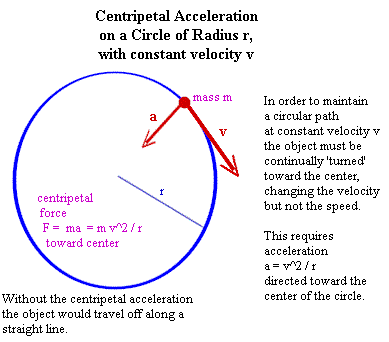"
Set 8 Problem number 7
Find the centripetal acceleration of an automobile
moving at 50.99 miles per hour moving around a circular track of radius 236 meters.
- If the automobile has a mass of 1255 kilograms, how
much force is required to hold the vehicle in the circle?
1 mile / hour = 5280 feet / 3600 sec = 5280 * .305
meters / 3600 sec = 1600 m / 3600 sec = .44 m/s, so 1 m/s = (1 / .44 ) mph = 2.25 mph,
which we will approximate as 2.3 mph.
A velocity of 50.99 mph, according to this
approximation, is ( 50.99 / 2.3) m/s = 22.16 m/s.
- At this speed, on a circle of radius 236 meters, the
centripetal acceleration (the acceleration toward the center), would be
- centripetal acceleration = v^2 / r = ( 22.16 m/s) ^
2 / 236 meters = 2.082 meters per second per second.
- The force required to accelerate a 1255 kg mass at
this rate is F = ma = ( 1255 kg)( 2.082 m/s/s) = 2612 Newtons.
- The centripetal acceleration of an object moving
along a circle of radius r at velocity v is a = v^2 / r; this acceleration is directed
toward the center of the circle.
- If the object has mass m, the force required to keep
the object in its circular path is F = m a = m v^2 / r; this force is also directed toward
the center of the circle.
Explanation in terms of Figure(s); Extension
The figure below shows an object moving with
constant speed v on a circle of radius r.
- The acceleration required to keep the object moving
in the circle, as opposed to the straight line along which it would travel if it had no
acceleration, is a = v^2 / r, and is directed toward the center of the circle.
- If the object has mass m, the force required to keep
it on its circular path will therefore be F = m a = m v^2 / r. This force will be directed
in the same direction as the acceleration, toward the center of the circle.

"
